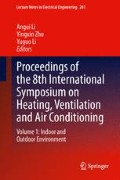Abstract
In order to study the indoor thermal comfort in the winter of subtropics region in which there is no heat supply system, field study of indoor thermal comfort was carried out in classrooms of a university in Xiamen. Data both from field measurements and questionnaire survey were collected and analyzed. Consequently, the neutral and preferred temperatures in the winter of Xiamen were obtained, which show slightly difference with previous studies across China. On the other hand, predicted mean vote (PMV), which was calculated by Thermal Comfort Program software, shows some deviations from the mean thermal sensation (MTS) summarized from questionnaires statistics. Finally, by using multivariate nonlinear regression model based on MATLAB, a new adaptive equation was developed, which could be used to predict the thermal response in classrooms in subtropics region. In addition, it was found that the predicted equation fits very well with the collected data, which reflects variation of thermal sensation in winter. Results from this study provide guidance for the measurement and prediction of thermal comfort in winter of the subtropics region.
Access this chapter
Tax calculation will be finalised at checkout
Purchases are for personal use only
References
de Dear RJ, Brager GS (1998) Developing an adaptive model of thermal comfort and preference. ASHRAE Trans 104(1):145–167
Humphreys MA, Nicol JF (2004) Do people like to feel ‘‘Neutral’’? Response to the ASHRAE scale of subjective warmth in relation to thermal preference, indoor and outdoor temperature, ASHRAE Transactions 110(2):569–577
ISO (1994) International Standard 7730, Moderate thermal environments: determination of PMV and PPD indices and specification of the conditions for thermal comfort. International Organization for Standardization, Geneva
Ashrae (1992) Standard 55–92, Thermal environmental conditions for human occupancy, American Society of Heating, Refrigeration and Air-conditioning Engineers, Atlanta, Georgia, USA
Fanger PO (1970) Thermal comfort. Danish Technical Press, Copenhagen
ISO (2005) International Standard 7730, Ergonomics of the thermal environment—Analytical determination and interpretation of thermal comfort using calculation of the PMV and PPD indices and local thermal comfort criteria. International Standard Organization, Geneva
ASHRAE (2004) ANSI/ASHRAE Standard 55 2004. Thermal environmental conditions for human occupancy
de Dear RJ, Fountain ME (1994) Field experiments on occupant comfort and office thermal environments in a hot-humid climate. ASHRAE Trans 100(2):457–475
Farraj F, Al-ajm DL (2010) Indoor thermal conditions and thermal comfort in air-conditioned domestic buildings in the dry-desert climate of Kuwait. Build Environ 45(3):704–710
Nicol F (2004) Adaptive thermal comfort standards in the hot-humid tropics. Energy and Buildings 36(7):628–637
Hwang RL, Lin TP, Kuo NJ (2006) Field experiments on thermal comfort in campus classrooms in Taiwan. Energy and Buildings 38(1):53–62
Li J (1996) The bioclimatic features of vernacular architecture in China. Renewable Energy 8:629–636
Mui KW, Wong LT (2007) Neutral temperature in subtropical climates—A field survey in air-conditioned offices. Build Environ 42:699–706
Yao R, Liu J, Li B (2010) Investigation and analysis on classroom thermal environment in winter in Chongqing. Appl Energy 87:1015–1022
Fanger PO (1972) Conditions for thermal comfort—a review, In: Proceedings of the Symposium on Thermal Comfort and Moderate Heat Stress (article in CIB W45), Building Research Establishment, UK, pp 3–15
Goldman RF (1999) Extrapolating ASHRAE’s comfort model. HVAC&R Research 5(3):189–194
Fanger PO (1972) Thermal comfort. McGraw-Hill, NY
huamei Z (2007) Research on calculate method of PMV under heating in winter through nomograph and equation. Building Energy Environ 26:45–50
Acknowledgments
This study is funded by National Science Foundation of China (51278349). This work is also supported by the “Guangdong Provincial Key Laboratory of Building Energy Efficiency and Application Technologies” and “Fujian Province Key Laboratory of Energy Cleaning Utilization and Development.”
Author information
Authors and Affiliations
Corresponding author
Editor information
Editors and Affiliations
Rights and permissions
Copyright information
© 2014 Springer-Verlag Berlin Heidelberg
About this paper
Cite this paper
Tao, Q., Li, Z. (2014). Field Study and Adaptive Equation of Thermal Comfort in University Classrooms in the Subtropics in Winter. In: Li, A., Zhu, Y., Li, Y. (eds) Proceedings of the 8th International Symposium on Heating, Ventilation and Air Conditioning. Lecture Notes in Electrical Engineering, vol 261. Springer, Berlin, Heidelberg. https://doi.org/10.1007/978-3-642-39584-0_14
Download citation
DOI: https://doi.org/10.1007/978-3-642-39584-0_14
Published:
Publisher Name: Springer, Berlin, Heidelberg
Print ISBN: 978-3-642-39583-3
Online ISBN: 978-3-642-39584-0
eBook Packages: EngineeringEngineering (R0)

